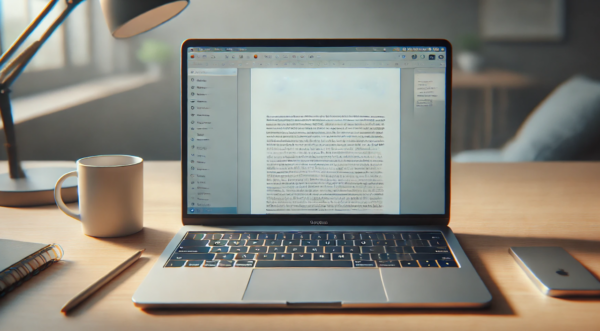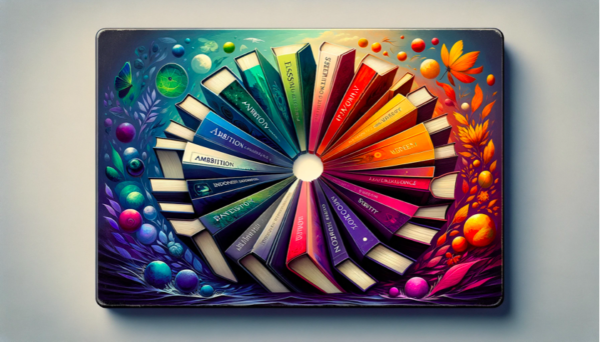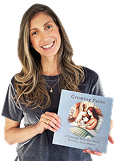Imagine opening a book where the text feels difficult to read or doesn’t match the story’s tone. No matter how engaging the content is, poor typography can make it harder for readers to stay immersed. Fonts play a crucial role in book design—they set the mood, enhance readability, and define a book’s personality. Proper book formatting goes hand in hand with font choice, as it ensures that your selected fonts are used consistently and effectively across the pages, creating a visually pleasing and easily navigable layout. Whether you’re creating a modern novel, a brand book, or a children’s story, selecting the right book fonts ensures a seamless reading experience.
In this guide, we’ll break down how to choose the best fonts for books, covering everything from serif vs. sans-serif fonts to font pairing, spacing, and size. Whether you’re a self-publishing author or designing a professional brand book template, this article will help you make smart typography choices that enhance readability and style.
Let’s dive into the world of book typography and find the perfect font for your project.
Fonts for Books: Understanding the Basics of Typography & Readabilit
Before selecting the right book font, it’s essential to understand the fundamentals of typography. A font refers to a specific style and size of a typeface, while a typeface is the overall design of the characters—examples include Times New Roman and Helvetica. A font family consists of related variations, such as bold, italic, and light styles.
In book design, fonts generally fall into two main categories: serif and sans serif. Serif fonts have small decorative strokes at the ends of letters, often used in print books for better readability. Sans-serif fonts, which lack these strokes, are commonly used in modern and digital formats for a clean, minimalist look.
By understanding these typography basics, you can confidently choose the best font for books—one that not only enhances aesthetics but also improves readability and the overall reader experience.
Font Categories and Characteristics
Fonts can be broadly categorized into two main types: serif and sans serif. Serif fonts have small lines or flourishes at the ends of the letters, while sans-serif fonts do not. Serif fonts are often used for body text in books because they are easier to read in print, while sans serif fonts are often used for headings and titles because they are more modern and attention-grabbing.
Within these two main categories, there are many different font styles and characteristics to consider. For example, serif fonts can be further divided into categories such as old-style, transitional, and modern. Old-style serif fonts, such as Garamond and Caslon, have a classic, traditional look and are often used for formal or academic writing. Transitional serif fonts, such as Baskerville and Georgia, have a more modern look and are often used for body text in books. Modern serif fonts, such as Bodoni and Didot, have a sleek, elegant look and are often used for headings and titles.
Sans serif fonts can also be further divided into categories such as grotesque, neo-grotesque, and humanist. Grotesque sans serif fonts, such as Arial and Helvetica, have a bold, geometric look and are often used for headings and titles. Neo-grotesque sans serif fonts, such as Univers and Akzidenz-Grotesk, have a more modern, streamlined look and are often used for body text in books. Humanist sans serif fonts, such as Gill Sans and Lucida Sans, have a more traditional, elegant look and are often used for body text in books.
In addition to these categories, fonts can also be characterized by their x-height, which is the height of the lowercase letters. Fonts with a high x-height, such as Arial and Helvetica, are often used for headings and titles because they are more attention-grabbing. Fonts with a low x-height, such as Garamond and Caslon, are often used for body text because they are easier to read.
Serif Fonts: The Traditional Choice for Readability
Serif fonts have been the go-to choice for print books for centuries. Their small strokes, or “serifs,” guide the reader’s eye smoothly across the page, making long passages of text easier to read. This makes them ideal for body text, especially in genres like literary fiction, historical fiction, and non-fiction. Selecting appropriate font sizes is also crucial for readability, with specific point sizes recommended for body text and titles to ensure a consistent and appealing presentation.
Popular Serif Fonts for Books:
- Times New Roman – A classic, widely used for both print and digital media.
- Garamond – Elegant and highly readable, often used in fiction.
- Adobe Caslon Pro – Favored by many designers for its timeless and professional look.
Serif fonts work well in novels, memoirs, and non-fiction because they offer a familiar and comfortable reading experience. If you’re looking for a reliable, traditional font for the main body of your book, serif fonts are often the best choice.
Sans Serif Fonts: Modern and Clean Typography
In contrast to serif fonts, sans-serif fonts are part of the different fonts used in design, offering clean, simple lines without decorative strokes. They provide a modern, minimalist look and are well-suited for digital reading formats due to their clarity on screens.
Best Uses for Sans Serif Fonts:
- Headings and chapter titles for a sleek and modern feel.
- Children’s books, where large, simple letters enhance readability.
- Non-fiction or design-focused books for a contemporary look.
Popular Sans Serif Fonts:
- Helvetica – Clean and modern, widely used in design.
- Arial – A standard, highly readable sans-serif font.
- Futura – Geometric and modern, perfect for innovative content.
When used thoughtfully, sans serif fonts can balance a traditional serif body text or serve as the main typeface for more modern and creative projects.
Font Size and Spacing: Enhancing Readability
Choosing the right font size and spacing is a crucial part of book layout, as important as the font itself. Standard book fonts are typically set between 10pt and 12pt for body text. For headings and chapter titles, larger sizes (14pt–18pt) help guide the reader through the content.
Key Spacing Elements to Consider:
- Letter spacing (tracking): Impacts how words flow. Too tight can strain the eyes; too loose can disrupt reading.
- Line height (leading): More space between lines improves readability.
- Margins: Adequate margins create breathing room on the page.
Adjusting these elements based on your book’s format ensures that your text is both inviting and easy to read.
Choosing the Right Font for Your Book Genre
Fonts should complement the book’s genre and audience. A whimsical font might suit a children’s story but feel out of place in a serious non-fiction work.
Font Suggestions by Genre:
- Fiction & Literary Works: Garamond, Baskerville (serif)
- Non-Fiction & Educational: Georgia (serif), Helvetica (sans serif)
- Children’s Books: Comic Sans (sparingly), Century Gothic (sans serif)
- Graphic Design or Modern Books: Futura, Avenir (sans serif)
Consider how your font reflects the mood and tone of your story. A well-chosen font will subtly communicate your book’s personality before a reader even turns the first page.
Display Fonts and Decorative Typefaces: For Titles and Covers
Display fonts are designed for titles, covers, and chapter headings. These fonts are often more decorative and bold, meant to capture attention. However, using them excessively can overwhelm the design.
Best Practices for Display Fonts:
- Use display fonts only for cover design, title pages, and headings.
- Pair with a simpler body text font for balance.
- Avoid overly decorative fonts for long passages of text.
A well-chosen display font can make your book cover pop while still maintaining readability inside. Read more on typography for book covers here.
Free Fonts vs. Paid Fonts: What’s Best for Your Book?
When choosing fonts, you’ll face the decision between using free fonts or deciding to purchase fonts.
Free Fonts (Pros and Cons):
- Google Fonts offers many quality options for free.
- It may lack uniqueness due to widespread use.
- Licensing might limit commercial use.
Paid Fonts (Pros and Cons):
- More unique and professional designs.
- Better support for print and digital formats.
- Licensing covers commercial use, offering peace of mind.
For professional publishing, investing in a quality font can set your book apart.
Special Considerations in Typography
When choosing a font for a book, there are several special considerations to keep in mind. One of the most important considerations is readability. The font should be easy to read, especially for body text. This means choosing a font with a clear, legible design and a sufficient x-height.
Another important consideration is consistency. The font should be consistent throughout the book, with the same font used for body text, headings, and titles. This helps to create a cohesive look and feel for the book.
In addition to these considerations, there are also several technical considerations to keep in mind. For example, the font should be compatible with the printing process and the paper being used. Some fonts may not print well on certain types of paper, so it’s important to test the font before printing.
Finally, there are also several aesthetic considerations to keep in mind. The font should complement the content of the book and enhance the overall reading experience. This means choosing a font that is appropriate for the genre and tone of the book. For example, a romance novel might use a more elegant, cursive font, while a science textbook might use a more modern, sans serif font.
Overall, choosing the right font for a book requires careful consideration of several factors, including readability, consistency, technical compatibility, and aesthetic appeal. By taking the time to choose a font that meets these considerations, authors and publishers can create a book that is both visually appealing and easy to read.
Common Font Mistakes to Avoid in Book Design
Avoid These Typography Pitfalls:
- Using too many fonts creates a chaotic and unprofessional look.
- Poor pairing of serif and sans serif fonts.
- Overusing Comic Sans or other informal fonts.
- Sacrificing readability for style.
Consistency is key. Choose a primary font and stick with it for a cohesive, polished design.
Final Tips for Perfect Typography
- Test print your book to check readability.
- Choose fonts that suit your target audience and book genre.
- Pair fonts carefully: a serif for body text, a sans serif for headings.
- Consider working with a book designer for expert guidance.
- Consider the use of web fonts for digital formats to ensure versatility across print and digital mediums.
Typography isn’t just about aesthetics—it’s about creating a smooth and enjoyable reading experience.
Conclusion: Crafting a Seamless Reading Experience
The right font doesn’t just make your book look good—it invites readers into your world and keeps them engaged. Whether you’re publishing a gripping novel, a professional non-fiction book, or a vibrant children’s story, your font choice is a silent storyteller working alongside your words.
Ready to design your perfect book? Let Spines help you bring your vision to life with professional book design tools and expert guidance. From font pairing to complete layout design, Spines makes it easy to create a book that’s as beautiful as it is readable.
Turn your vision into a reality and start your book design journey today with Spines!
Your Publishing Journey Awaits – Start NowFAQs – Book Fonts
Q: What is the best font for a book?
The best fonts for books are typically serif fonts, as they improve readability in long-form text. Popular choices include Garamond, Times New Roman, Baskerville, and Georgia. These fonts provide a classic, professional look and are widely used in both fiction and non-fiction books.
Q: What font do most publishers prefer?
Most traditional publishers prefer serif fonts for print books, such as Garamond, Minion Pro, or Caslon. For digital books (eBooks), sans-serif fonts like Arial, Helvetica, or Verdana are often recommended for better screen readability.
Q: Which font style is best for reading?
Serif fonts are considered best for reading in printed books because the small strokes at the ends of letters guide the eye smoothly across the page. For digital books, sans-serif fonts are often preferred for better clarity on screens.
Q: What font size is commonly used in books?
The standard font size for printed books typically ranges from 10pt to 12pt, depending on the typeface. For eBooks, font sizes can be adjusted by the reader, but most publishers recommend a default size of 12pt–14pt for better readability.
Q: What font are the Harry Potter books written in?
The Harry Potter books by J.K. Rowling are set in Adobe Garamond in most published editions. The signature Hogwarts letter font is often recreated using Lumos or Harry P fonts for decorative purposes.
Q: What is the most common font for fantasy books?
Fantasy books often use classic and elegant serif fonts like Garamond, Palatino, or Baskerville to evoke a timeless and immersive feel. Some fantasy books also incorporate custom fonts for chapter titles and decorative elements to enhance the magical atmosphere.
Q: How should I format my book for readability?
For best readability in print books, use:
- Font: A serif typeface like Garamond or Baskerville
- Font size: 11pt or 12pt
- Line spacing: 1.3 to 1.5 for better legibility
- Margins: At least 0.5″ to 1″ for professional spacing
For eBooks, ensure your formatting adapts well to different screen sizes and allows readers to adjust font settings.








